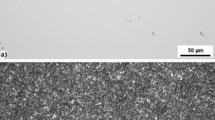Abstract
A modified torsional split-Hopkinson bar is intoduced and used to study material response associated with a sudden reduction of stain rate during high-rate plastic deformation. In tests on 1100-0 aluminum iniial deformation at a strain rate of approximately 2400 s−1 is reduced by a factor of 15 after 200 μs of high-rate deformation. After the reduction, the deformation continues at the low rate for additional 550 μs. The change in the strain rate is obtained by using a stepped input bar. The results for 1100-0 aluminum show a decrease in the flow stress following the reduction in the strain rate. A short delay exists between the beginning of the strain-rate reduction and the response of the stress. The magnitude of the drop in the stress agrees with the difference in flow stress expected in constant-strain-rate tests in the corresponding high- and low-strain rates. Following the stress reduction. The stress remains essentially constant with no hardening during the subsequent deformation at the low rate.
Similar content being viewed by others
References
Kolsky, H., “An Investigation of the Mechanical Properties of Materials at Very High Rates of Loading,”Proc. Phys. Soc., London,62-B,676–700 (1949).
Cambell, J.D. andDowling, A.R., “The Behavior of Materials Subjected to Dynamic Incremental Shear Loading,”J. Mech. Phys. Solids,18,43–63 (1970).
Nicholas, T., “Strain-Rate and Strain-Rate-History Effects in Several Metals in Torison,”Experimental Mechanics,1, (8),370–374 (1971).
Frantz, R.A., Duffy, J., “The Dynamic Stress-Strain Behavior in Torsion of 1100-0 Aluminum Subjected to a Sharp Increase in Strain Rate,”ASME J. Appl. Mech.,39,939–945 (1972).
Senseny, P.E., Duffy, J. andHawley, R.H., “Experiments on Strain Rate History and Temperature Effects During the Plastic Deformation of Close Packed Metals,”ASME J. Appl. Mech.,45,60–66 (1978).
Duffy, J., “The Dynamic Plastic Deformation of Metals: A Review,”AFML-TR-82-4024, Air Force Mat. Lab. Wright-Patterson AFB, Dayton, OH (1982).
Lipkin, J., Campbell, J.D. andSwearengen, J.D., “The Effects of Strain-Rate Variations on the Flow Stress of OFHC Copper,”J. Mech. Phys. Solids,26,251–268 (1978).
Leroy, M., Raad, M.K., Nkule, L. andCheron, R., “Influence of Instantaneous Dynamic Decremental/Incremental Strain Rate Tests on the Mechanical Behavior of Metals-Application to High-Purity Polycrystalline Alunium,”Mechanical Properties at High Rates of Strain, ed. J. Harding, The Inst. of Phys., Bristol and London, 31–38 (1984).
Lewis, J.L. andCampbell, J.D., “The Development and Use of a Torsional Hopkinson-bar Apparatus,”Experimental Mechanics,12,502–524 (1972).
Lindholm, U.S., “Some Experiments with the Split Hopkinson Pressure Bar,”J. Mech. Phys. Solids,12,317–335 (1964).
Author information
Authors and Affiliations
Rights and permissions
About this article
Cite this article
Gilat, A., Pao, Y.H. High-rate decremental-strain-rate test. Experimental Mechanics 28, 322–325 (1988). https://doi.org/10.1007/BF02329030
Received:
Accepted:
Issue Date:
DOI: https://doi.org/10.1007/BF02329030




